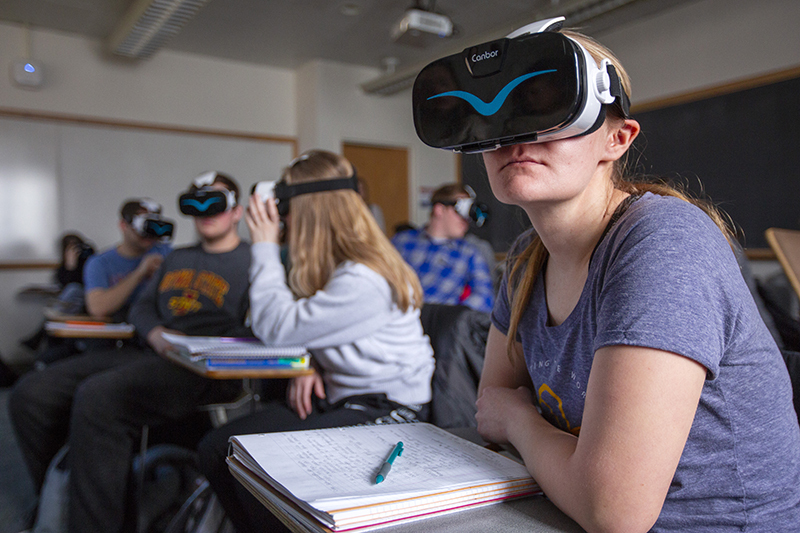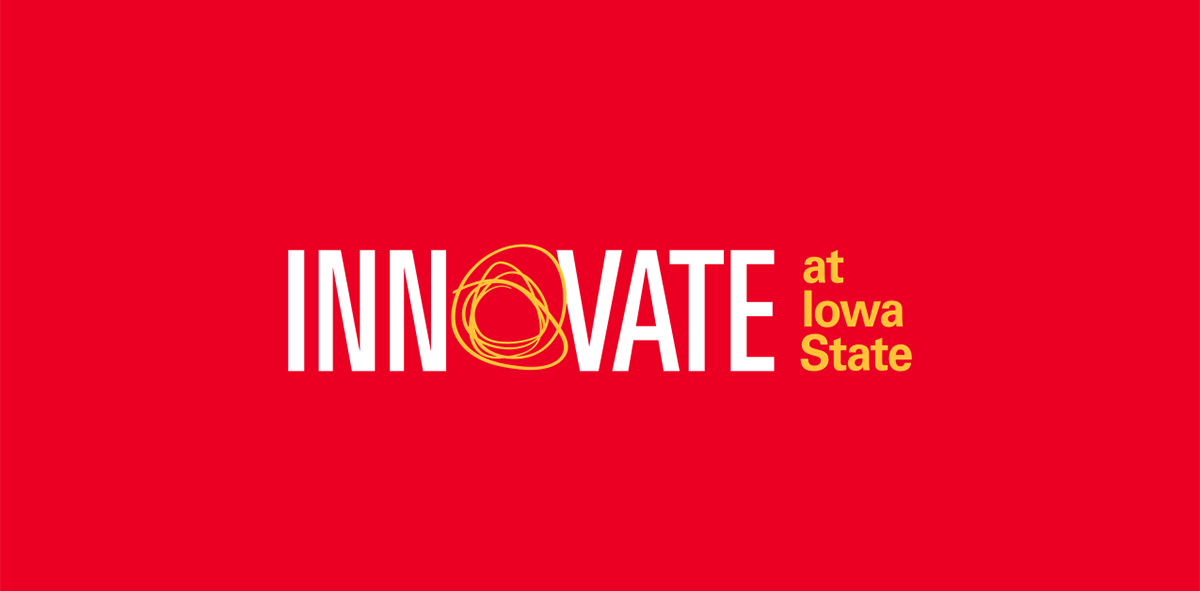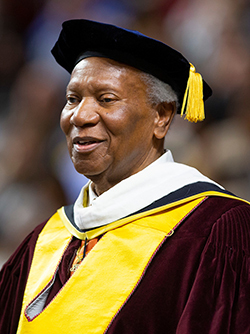With VR, students lead classmates on trips around the world

Spanish 304 student Jennifer Seth follows along as classmates lead a virtual reality tour of some notable sites in Spain. Photo by Christopher Gannon.
After his first semester teaching Spanish 304, James Nemiroff was confronted with a problem.
A good chunk of the material in Spanish for Global Professionals, which focuses on business vocabulary and intercultural competence, is a need-to-know foundation for a variety of Spanish-language countries -- social, historical, economic and political basics detailed in the course's textbook. It's important, but a potentially dry subject for lecturing.
"I found my blabbing at them for 50 minutes was a little boring," said Nemiroff, a Spanish lecturer in the world languages and cultures department. "Often, students' attention can drag when listening in a foreign language."
The solution? Group presentations on the background and issues facing a Spanish-speaking nation, a newly added project with a technological component. A piece of that presentation is a virtual reality tour each group makes, illustrating points from their report with 360-degree photos they jointly experience as a class. Instead of listening to Nemiroff talk about a nation's political history, students lead a quick tour of a few of its most instructive and interesting sites.
"I want to give them that experience of 'Yeah, I was in Spain for about five minutes,'" Nemiroff said.
Provoking imagination
Two sections of Spanish 304 last fall were Nemiroff's trial run for the VR-assisted assignment, and it went well. Student engagement was better, helping sharpen spontaneous conversation skills. Though the images are static photos, the VR tours feel more alive than a video – reinforcing active instead of passive learning and encouraging realistic speaking and listening, he said.
Nemiroff plans to research the value of using virtual spaces in teaching a second language.
"The VR environment, I think, provokes their imagination differently," he said. "They take ownership in a unique way."
Another class section is preparing VR tours this semester, with the first group presenting last week on Spain. Roughly two dozen students slipped on the headsets, which hold cell phones to display the images. As presenting students acted as tour guides, their classmates craned in various directions to explore Camp Nou, the massive stadium where soccer power FC Barcelona plays. When presenters prompted where to look with an arrow, their heads all snapped in the same direction. On a tablet the presenting group monitors, smiley faces designate where each headset is looking.
Affordable and easy
The tours are the first classroom assignment to use of the VR cart the department purchased last year. Jacob Larsen, director of the Language Studies Resource Center, saw VR used at a conference and thought it held some promise for language instruction. Some faculty showed interest, and Larsen and graduate assistant Alison Kirwen researched the technology. The gear is affordable and easy to use, given it is consumer-level headsets and cell phones -- a far cry from, say, the total immersion of the Virtual Reality Application Center's C6.
"To create a user-generated environment is a whole different level of development," Larsen said.
The VR headset cart cost about $8,000, with half of the cost covered by the department budget and half by College of Liberal Arts and Sciences student computer fee funds, Larsen said. The setup consists of 35 phones, 45 headsets and a dedicated router. The tours are created with a free Google app, Expeditions, which integrates photos created for its street view maps and user-uploaded images.
Building the tours is intuitive enough that students rarely stop by the Language Studies Resource Center for assistance, Larsen said. Simplicity is a key feature.
"The technology has to be accessible enough to not get in the way of the learning," Larsen said.
The department also purchased two 360-degree cameras to create immersive videos from its study abroad programs. Last summer, department chair Chad Gasta shot video during his trip to Valencia, Spain. This summer, additional videos are planned from the department's other programs. Viewed on the VR headsets, the videos can be a recruiting tool for study abroad or a chance for students already signed up to get a sense of what an unfamiliar place will be like.
"It's another way for them to visualize interacting with the Spanish-speaking world," Nemiroff said.
'Innovate at Iowa State' campaign launches this month
Two years into Wendy Wintersteen's presidency, one of her top initiatives -- infusing the Cyclone student experience with innovation and entrepreneurship -- accelerates this semester with the April opening of the Student Innovation Center. In conjunction, the university is rolling out a branding campaign to package and highlight the growing opportunities across academic programs and around campus.

Innovate at Iowa State reflects the university's culture going back decades, said Jacy Johnson, interim executive director of strategic relations and communications.
"The strength of the branding campaign is that it's authentic, it's part of our DNA, it's who we've always been as a land-grant university," she said. "This campaign plays a critical role in translating the president's vision into action. It amplifies and promotes a culture of innovation that offers so many opportunities in teaching, research and outreach."
Phased approach
"In five years, Iowa State will become widely recognized for promoting, teaching and practicing innovation and entrepreneurship for the good of our students, faculty and society."
-- President Wendy Wintersteen
The first phase of the campaign will target prospective students and the campus community of students, faculty and staff. It will be visible through social media, Google search advertising, displays on digital monitors around campus, CyRide bus boards, advertising in the Iowa State Daily and a large exterior banner at the Iowa Events Center in downtown Des Moines, just in time for the high school state tournament season.
In addition, individuals who have been shaped by Iowa State's culture of innovation will share their experiences with legislators March 5 at the annual ISU Day at the Capitol.
A second phase, focused on business and community leaders, legislators, alumni, stakeholders and national influencers will begin in July.
The goal, in five years, is to raise the university's reputation in innovation among these audiences to build and strengthen relationships and encourage advocacy.
Complement to adventure theme
University marketing director Carole Custer, introducing the campaign last week to campus leaders, said Innovate at Iowa State won't replace the Adventure student recruitment campaign of the last 15 years. Innovation is one of the adventures students could have during their campus years, she said.
In addition to its tie-in to the Student Innovation Center opening as a one-of-a-kind home base for innovation, Custer said the campaign makes sense now for several reasons:
- Higher education is an increasingly competitive marketplace. "It's critical, now more than ever, that we stand out -- and carve out -- our distinctive place in that marketplace."
- "It aligns with our students, the Gen Z audience. Based on our research, they want to be creative, do things on their own and see their dreams make an impact."
- Innovation is a core strength of ISU with ambassadors across campus -- including Wintersteen, college deans and directors -- who model innovation every day and encourage others to be a part of it.
- An anonymous donor who supports Wintersteen's vision for the university stepped up to help fund the marketing campaign so Iowa State can tell its story.
Share your stories
Campus communicators soon will have access to assets -- campaign art for use in promotional efforts -- along with guidelines for creating messages and using the visual elements. The assets will be added to a password-protected website. Custer and Johnson will host a webinar for communicators to summarize the campaign and answer questions. The webinar will be archived for those not able to participate live.
The Innovate at Iowa State website is live this week. Custer said it's in its infancy now, with content added as it becomes available. She said the campus community will help build that content by sharing "what's going on in your program, department, college, your building." Specifically, she encouraged features about innovative students and the many ways student groups use the Student Innovation Center.
"Make entrepreneurship and innovation a regular topic in your content, showcase related program offerings and courses," Custer said. "Talk about all the practical opportunities your students have to develop an entrepreneurial mindset."
Music Hall is named for Simon Estes

Architect sketch of pedestrian walkway across University Boulevard east of Jack Trice Stadium. Image courtesy of athletics department.
The athletics department will begin planning an estimated $8 million-$12 million pedestrian bridge over University Boulevard east of Jack Trice Stadium following a state Board of Regents initial green light Feb. 5. The meeting was shortened by a protest from members of Iowa Student Action.
The gateway project includes an elevated walkway all the way to the stadium's east concourse to create a safe pedestrian route between the stadium and parking. In addition to its fan safety function, it will be designed to enhance the primary entry to campus from the south. Funding will come from athletics department operating funds and private gifts.
On another project related to the football program, the board approved a sale of $59.9 million in 20-year athletic facilities revenue bonds to construct and equip the five-level sports performance center east of the Bergstrom football facility and a one-story addition on its west side. The project includes a north extension of the stadium concourse and a north plaza on the site of the Olsen Building, which will be demolished.
Simon Estes Music Hall

Simon Estes
The board approved Iowa State's request to name Music Hall for opera vocalist Simon Estes, the music and theatre department's F. Wendell Miller Distinguished Artist-in-Residence since 2000. Estes, 81, has helped attract world-class students to the department and mentored many of them for admission to prestigious music schools following their undergraduate years. He received an honorary Doctor of Humane Letters degree from Iowa State in 1997.
The board waived its policy that mandates a two-year wait following retirement before a building may be named for a regent university employee. The building's name is Simon Estes Music Hall.
FY21 parking rates
Proposed increases of 3% to 3.3% on employee parking permits in fiscal year 2021 were in the consent agenda and are scheduled for final approval at the board's April meeting. If approved, the increases would be $6 for general staff permits, $17 for reserved permits and $30 for 24-hour reserved spots. Employee motorcycle permits would go up $2 next year. Permits for the Memorial Union ramp would go up about 2.5%, as proposed. The MU changes vary from a $5 increase for a summer permit to a $15 increase for an annual permit.
Hourly parking in the MU ramp would go up 25 cents per hour, as proposed, with the daily maximum rising from $13 to $15. The price of the first hour would rise to $2.25, additional hours 2-5 would rise to $1.75 per hour, and hours 6-8 would rise to $1.50 per hour. Special fees, for example illegal exit or lost ticket charges, will remain at current rates.
In addition to ramp maintenance and equipment replacement, MU leaders will set aside revenue for an assessment of the structure's condition.
July 1: Proposed parking increases
|
Permit |
Proposed |
Current |
|
24-hour reserved |
$1,005 |
$975 |
|
Reserved |
$582 |
$565 |
|
General staff* |
$186 |
$180 |
|
Departmental |
$217 |
$210 |
|
Vendor |
$325 |
$315 |
|
Motorcycle (employee) |
$62 |
$60 |
|
Memorial Union ramp |
|
|
|
Annual |
$585 |
$570 |
|
Fall or spring |
$256 |
$250 |
|
Winter |
$250 |
$244 |
|
Summer |
$207 |
$202 |
*Includes lots designated for residence department and Ames Lab
Football game day band incident
Board president Michael Richards reported the investigation has concluded into allegations of verbal or physical assaults on University of Iowa marching band members Sept. 14 outside Jack Trice Stadium following the intrastate football game. He said "it was determined there was not enough evidence available to substantiate the pursuit of any charges."
But he said game day safety has to be a priority, and he announced the three university presidents will work together to review and improve the game management policies on each campus before fall semester begins.
"We want to be able to provide a safe environment for everyone, and don't want anyone to feel unsafe at any of our events. We applaud the efforts of all three schools to come together and implement protocols to meet that end," Richards said.
At a Sept. 24 media event, Cyclone athletics director Jamie Pollard said ISU police were investigating five reports of alleged abuse to band individuals or proprerty that had been collected and forwarded to them from University of Iowa police.
Student financial aid update
In their annual report to the board's academic and student affairs committee, the regent universities' three directors of student financial aid said undergraduate aid in the last decade has shifted to a greater dependence on university and private (organizations, companies, foundations) assistance when state funds declined and federal funds cover less of the rising cost of attendance.
Decade comparison: Undergraduate aid at the three regent universities
|
Source of aid |
2008-09 |
2018-19 |
|
Federal (student loans) |
59.2% |
48.4% |
|
State (grants) |
1.2% |
0.3% |
|
Regent universities (scholarships, grants, employment) |
26.0% |
35.4% |
|
Other (private, community scholarships, awards) |
13.1% |
15.9% |
University aid to Iowa State undergraduates, which has climbed steadily for the last decade, reached $140 million in 2018-19. That included a record $115 million in scholarships and grants, about 70% of which was awarded based on financial need.
In 2018-19, in-state students graduating from Iowa State with debt (61% of resident undergraduates) had an average debt of $26,304. Average nonresident debt at graduation was $31,510 for those with debt. The national average debt at graduation last year was $29,200.
Cindy Seyfer, University of Iowa director of student financial aid, also talked about institutional assistance to students that doesn't show up on these annual charts -- for example, campus food pantries and emergency grants for rent or a car repair. This assistance is critical to retaining students and helping them complete their degrees, she said.
The board also approved these Iowa State agenda items:
- Project description and budget ($16 million) to replace the ISU power plant's central control system. It will occur in 12 phases over eight years in order to maintain steam, chilled water and electricity service to campus throughout the transition. The university's utility repair and utility infrastructure funds will cover the cost.
- Project description and budget ($3.8 million) for improvements to four parking lots over two summers (2020-21): 54 and 66 in the Richardson Court residence neighborhood, 18 along Morrill Road on central campus and 74 on Union Drive north of Lake LaVerne. The project also replaces select underground utilities. Funding sources are ISU parking, $2.1 million; ISU utilities, $1.4 million; Institutional Roads Fund (Iowa DOT), $200,000; and university funds, $150,000.
- Due to the shortened meeting, the board did not receive student residence and dining rate proposals for next year or the annual report on student retention and graduation.
Communication is key with learning technologies in Canvas
The decision to use Canvas as Iowa State's learning management system (LMS) three years ago expanded the tools available for teaching in and out of the classroom. New learning technologies have made access to information easier -- and in some cases less expensive -- for students.
"It is not our intent to limit what the instructor can use," said Center for Excellence in Learning and Teaching (CELT) learning technologies coordinator Amy Ward. "We want to support them with the tools they want to use, but we want to make sure they are secure, accessible and affordable."
Communication
At last month's Faculty Senate meeting, a student government representative raised a question about the cost and effectiveness of the online discussion platform Packback used in a couple of courses this semester. The subscription-based ($25) app is designed to enhance students' communication and critical thinking skills.
Packback came into use in Canvas through immediate access, which allows instructors to provide course materials at a lower cost.
"Instructors often talk to the company to learn about the app and then communicate with the ISU Book Store to add it to their book package," Ward said.
Issues can arise from something as simple as having access to the technology. Ward said keeping communication going throughout a semester can be helpful in evaluating a new technology.
"Whenever there are issues we try to encourage students to talk to the instructor if they feel a tool used in the course is not effective," she said. "It may be the instructor is trying something new to see if it is productive and won't know there is an issue unless someone speaks up."
Savings
Currently, 34 apps are approved for use in Canvas. Some have a fee, while others are free. One of the most often used is RedShelf.
"It combines online course materials from several publishers. Students don't have to buy a physical book," Ward said. "Materials are available through Canvas on the first day of class."
Immediate access is part of the affordable course content initiatives that decrease costs for students. English faculty saved students $179,000 in one semester by using electronic materials for their courses.
Open educational resources, or free educational materials, continue to grow in use across campus. The University Library also offers course reserves, which provide textbooks or other materials at no cost. Direct links to the course reserves recently were added into Canvas.
In-class apps
There are several apps in Canvas instructors use in classes. Some popular ones include:
- Top Hat, an in-class feedback system that lets the instructor administer quizzes and see student results in real time. Each semester, Top Hat representatives come to campus to meet with instructors to make sure it is set up correctly, Ward said.
- WebEx, a video collaboration tool that can record class meetings. Instructors also are able to hold virtual office hours to fit their schedules.
- Grammarly, which provides grammar and spell-check options and plagiarism detection. It is one of the newest additions, added this semester.
Help
CELT has open labs three days a week where instructors can learn more about technology they want to add to their courses.
"We just want to help them get the most out of it," Ward said. "They can try it on us before they use it in a class and make sure it does what they want."
Whenever an instructor wants to add a new learning technology to a class, the LMS enterprise team -- a group of people from CELT and information technology services -- tests it before it is approved. It is a process that can take two to three months.
"We look at pedagogy, security, accessibility, support, and cost for the university and students," Ward said.
New university committee to address sustainability
President Wendy Wintersteen has established a new university committee to improve sustainability at Iowa State. The University Sustainability Committee is charged with developing a set of actionable recommendations that will increase energy efficiency, energy conservation and use of renewable energy with the goal of moving Iowa State toward carbon neutrality.
The Faculty Senate first recommended the creation of a sustainability committee as part of a 2018 resolution on climate change. Student Government approved a similar resolution in 2019. Both resolutions acknowledge the university's past and current efforts to reduce greenhouse gas emissions and outline a number of additional actions necessary for the university to achieve carbon neutrality.
The University Sustainability Committee, chaired by Bill Gutowski, professor of geological and atmospheric sciences, will work with, and build off, the efforts of existing campus groups involved in sustainability efforts, including facilities planning and management and the office of sustainability's Live Green initiative.
Joining chairman Gutowski on the committee are:
- Robert Brown, Anson Marston Distinguished Professor, Gary and Donna Hoover Chair, department of mechanical engineering, and director of the Bioeconomy Institute
- Brianna Burke, associate professor, department of English and Native American studies program
- Bob Currie, director, facilities services
- Kelsie Ferin, graduate student in agricultural meteorology, department of agronomy
- Kristine Heflin, associate director, Memorial Union
- Mark Kruse, director, utilities services
- Paul Lasley, professor, department of sociology
- Dan Loy, professor, department of animal science, and director of the Iowa Beef Center
- Ruth MacDonald, professor and chair, department of food science and human nutrition and assistant dean, College of Agriculture and Life Sciences
- Peter Orazem, University Professor, department of economics
- Merry Rankin, director, office of sustainability
- Mark Rasmussen, director, Leopold Center for Sustainable Agriculture
- Karen Rodekamp, assistant director, ISU Dining
- Ian Searles, undergraduate student in geology
- Toni Sleugh, undergraduate student in biology; chapter chair of Climate Reality
- Gene Takle, emeritus professor, department of geological and atmospheric sciences and department of agronomy
- James Tener, associate teaching professor, department of music and theatre
- Izzy Wilde, undergraduate student in community and regional planning
- Jeff Witt, director, utilities services
Fall emerging leaders class is forming now
Nominations for the Emerging Leaders Academy's 2020-21 cohort are due March 2.
ELA, sponsored since 2009 by the office of the senior vice president and provost, fosters leadership development of faculty and professional and scientific staff serving in leadership roles -- or those who aspire to be. During the academic year, the ELA cohort -- approximately two dozen members -- participates in monthly leadership activities led by content experts and facilitators. The activities are designed to encourage self-reflection, develop contextual skills and create leadership competencies. Participants complete modules on topics such as strategic planning, performance management, budget development and an inclusive organizational culture. Cohort members also work in teams to complete a university-related capstone project.
The new cohort members will be selected by April 10. The academy will meet 10 times for a full day between September 2020 and May 2021.
Information about eligibility criteria and the nomination process is online. A nomination package includes the ELA nomination form, nominator's letter and an essay and resume from the nominee. Self-nominations won't be accepted. Questions about the program or the nomination process should be directed to ELA co-director Katharine Hensley, faculty professional development coordinator in the provost's office. Rod Bagley, professor and chair of veterinary clinical services, also co-chairs the program.
